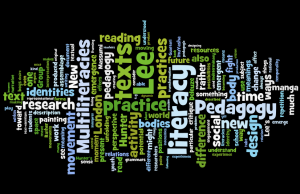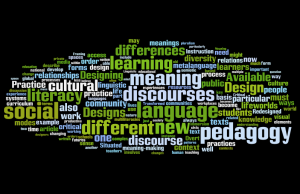To begin our discussion on the blog I’d like to resurrect a post I made a year ago today, on 3 July 2013. I hope my observations below will serve as a catalyst for discussion of our readings, and I encourage you to join the conversation in this collaborative writing space by commenting or posting yourself.
—
The New London Group is a collective of 10 researchers who met in 1994 to discuss what they perceived to be a fundamental societal problem:
that the disparities in educational outcomes did not seem to be improving. We agreed that we should get back to the broad question of the social outcomes of language learning, and that we should, on this basis, rethink the fundamental premises of literacy pedagogy in order to influence practices that will give students the skills and knowledge they need to achieve their aspirations. (NLG, 1996)
In their “programmatic manifesto,” they outline a number of changes that demand corresponding changes in instructional methodologies. These include the following:
-
– Changes in Technology for Knowledge Mobilization
– Changes in Workplace (e.g., PostFordism and Fast Capitalism)
– Changes in Public Lives (e.g., privatization, deregulation, corporatization of education — market logic)
– Changes in Political Logic (e.g., Old World [standardization] / New World [assimilation] logic)
– Shifts in cultural and linguistic diversity
In contemplating how to move forward, they introduce the notion of design, which “recognizes the iterative nature of meaning-making, drawing on Available Designs to create patterns of meaning that are more or less predictable in their contexts” (NLG, 1996). Designing, they argue, “always involves the transformation of Available Designs; it always involves making new use of old materials” (NLG, 1996). They also note that Available Designs are varied, identifying the following: Linguistic Design, Visual Design, Audio Design, Gestural Design, Spatial Design, and Multimodal Design. For students to be successful, they argue, they invariably require a metalanguage to describe and reflect on their design process.
Finally, the New London Group observes
pedagogy is a complex integration of four factors: Situated Practice based on the world of learners’ Designed and Designing experiences; Overt Instruction through which students shape for themselves an explicit metalanguage of Design; Critical Framing, which relates meanings to their social contexts and purposes; and Transformed Practice in which students transfer and re-create Designs of meaning from one context to another. (NLG, 1996; bold added)
The above-summarized document is one of the most cited in contemporary literacy research. Although the authors describe it as “open and tentative,” and welcome debate and elaboration, there has been little critique of the ideas espoused. Rather, as Leander and Boldt (2013) observe, “More than any other document, ‘A Pedagogy of Multiliteracies’ streams powerfully through doctoral programs, edited volumes, books, journal reviews, and calls for conference papers, as the central manifesto of the new literacies movement,” and is the dominant conceptual paradigm in new literacy studies. A design paradigm, they posit, is not the only way to conceptualize literacy studies and has some key limitations.
Contemplating the NLG article and the above discussion, here are some questions for your consideration:
- 1. What appears to be the premise, or purpose, of education in the NLG’s view? Are there other valid purposes of education that might productively be considered?
2. In 1994 the NLG were concerned that “the disparities in educational outcomes did not seem to be improving.” In your estimation has there been any advancement in terms of erosion of such disparities? If not, why not?
3. To what extent are students availing themselves of the gamut of “Available Designs”? If they are not doing so, what might be the main barriers?
4. Look up the definition and etymology of design in multiple sources, including the OED. Do you feel the paradigm introduced — learning as design — is a useful one? Are you able to propose any other productive approaches?
5. The NLG notes that they are from disparate parts of the world; however, the ten researchers represent only 3 countries: Australia, Britain and the United States. Expanding on question 3, what approaches might have emerged in a meeting of a more diverse group of researchers?
6. A key challenge identified in education is that young people appear to shift from an innate desire to learn in preschool and non-formal settings to recalcitrance in formal settings. Some claim, in keeping with the NLG manifesto, that this is because content and instructional approaches are too far removed from students’ diverse experiences and interests. Would you agree and, if so, is the approach identified by the NLG one way to ameliorate this challenge?
7. Finally, contemplate the two images at the bottom of this post. These images, as you likely know, are “Wordles,” essentially simple visualizations of the word frequency in two different documents, where larger words represent greater instance of that term in the document (“stop words” — common English words — are omitted here so that the focus can be on “content” words). The texts visualized are the NLG article (1994) and Leander and Boldt’s response (2013). Which is which? Can anything be gleaned about the nature or focus of these texts from simply examining word frequency in these two documents?
If possible, upload your group’s thoughts on these questions as a comment to this post.
__________
References
Leander, K., & Boldt, G. (2013). Rereading “A Pedagogy of Multiliteracies” Bodies, Texts, and Emergence. Journal of Literacy Research, 45(1), 22-46. (UBC Electronic Holdings)
New London Group. (1996). A pedagogy of multiliteracies: Designing social futures. Harvard Educational Review, 66(1), 60-92.


4 replies on “Revisiting the Multiliteracies Manifesto”
Question 3:
Potential barriers to access: socioeconomics, language, gender, etc. Students still face hindrances to learning, absorbing, and students’ valuing material.
Question 5: What might be included to make the research more disparate, diverse -> story telling, oral history, Indigenous knowledge, cultural ceremony, symbolic significance and difference. Including more diverse ways of teaching and learning beyond the limited cultural scope of the members of the NLG.
Question 6: We do agree that students are not engaged because the way they are taught does not relate to their interests and various ways of understanding and interpreting knowledge.How to bridge the gap between early life education (where students are willingly engaged) and more “mature” learning. Pedagogy as complex integration of factors: situated practice, overt instruction. Students can transfer and transform information, content and knowledge. The NLG answers this issue but this is not only mode, yet a potentially useful way.
Question 1:
The NLG strives to prepare students in a way which will seamlessly transition them into citizens participating fully in public, community, and economic life.
Other valid purposes of education that might be productively considered are that students should be guided through a journey of introspecting into their own passions and plans for future. While participating in public, community, and economic life is important, it is also crucial for students to learn about themselves during this process.
Question 5:
A more diverse group of researchers should have been incorporated because experiences outside of the Western culture would give a more valid representation of other various groups. If one examines only Western culture, the results may be biased and non-transferrable to other cultures. For example, literacies in non-Eurocentric countries such as China and Egypt would present an entirely different paradigm in regards to language and pedagogy.
Ania, Nabila, Tina, Vinay
George’s Group: George, Ashley, Danielle, Anna F., Justin, and Amanda
Based on the integration of different modes of meaning-making (textual to audio, visual, behavioural, and so forth), we wonder: are we losing control with multiple literacies?
Question 6
During the preschool days, children are often encouraged to inquire and learn about their daily life surroundings. However, as they enter later elementary years and high school, they are shifted towards pen and paper education. We believe that by introducing multiple literacies in the classrooms, students are able to explore the different options provided to them.
Erin, Jenny, Kelly, Rachel